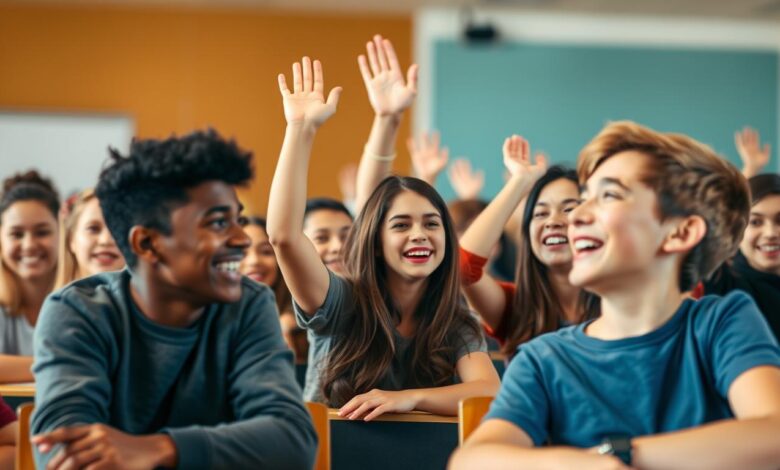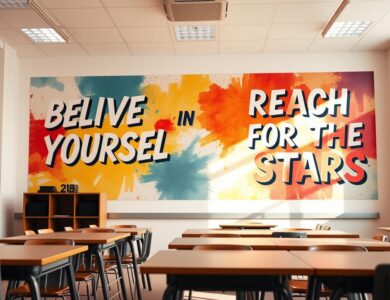
Engaged learning is key for Student Motivation academic success. When learners are motivated, they do better in class. They learn more and reach their goals.
Creating a supportive learning space is vital for student engagement. Knowing what motivates students helps educators and parents. They can then use these insights to boost learning enthusiasm.
A motivated learner can face challenges and succeed. We will look at how to increase student motivation. We’ll see how educators and parents can make learning more engaging and supportive.
The Science Behind Students Motivation
The science of student motivation shows how both internal and external factors affect learning. These factors are key for teachers to create a learning environment that keeps students interested.
Intrinsic vs. Extrinsic Motivation
Intrinsic motivation comes from wanting to learn for itself. Extrinsic motivation comes from outside rewards or praise. Intrinsic motivation leads to deeper learning and lasting interest.
The Psychology of Engagement in Education
Engagement in education is tied to motivation. When students are motivated, they dive into learning more.
Motivation’s Impact on Retention
Motivation greatly affects how well students stick with their studies. Retention isn’t just about staying in school. It’s also about how deeply students are involved in their learning.
How to Identify Motivation Issues in the Classroom
Student motivation is very important for success in school. It’s crucial to spot problems early. Teachers need to know the signs of low motivation in students.
Recognizing Behavioral Warning Signs
Changes in behavior can show a student is losing motivation. Spotting these signs is the first step to help.
Assessing Academic Performance Patterns
Looking at a student’s grades can show if they’re motivated. Regularly poor grades or a big drop in scores means trouble.
Connecting Effort to Results
By catching these problems early and figuring out why they happen, teachers can create plans to improve student engagement and goal setting. This helps boost student motivation.
Designing a Motivation-Friendly Learning Environment
A well-designed learning environment can really boost student motivation. It’s not just about the classroom setup. It’s also about creating a safe and inclusive atmosphere.
Optimizing Physical Classroom Setup
The way a classroom is arranged can really affect student engagement. Arrangement strategies for collaboration help build a sense of community and teamwork.
Arrangement Strategies for Collaboration
For better collaboration, try arranging desks in clusters or circles. This makes group work and discussions easier. Flexible seating options also improve comfort and engagement.
Creating Emotional Safety and Inclusion
Emotional safety is key for student motivation. Using positive reinforcement helps create an inclusive environment.
Techniques for Building Community
Educators can build community through activities that bond students. This includes icebreaker games, team-building exercises, and class discussions. By making students feel they belong, educators help them develop positive learning habits.
Developing Strong Teacher-Student Connections
Teacher-student relationships are key to a supportive learning environment. They help students do well in school. When teachers connect well with students, it boosts students motivation and keeps them engaged.
Building Trust Through Consistency
Consistency is vital for trust between teachers and students. Teachers who stay consistent in their teaching and interactions create a stable and reliable classroom.
Daily Practices for Relationship Building
Simple daily actions like greeting students at the door and having one-on-one chats help a lot. Being ready to answer questions shows a teacher cares about their students’ success and happiness.
“The way we talk to our children becomes the way they talk to themselves.”
— Peggy O’Mara
Implementing Personalized Attention Strategies
Personalized attention makes students feel valued and understood. Tailoring lessons to fit each student’s needs boosts self-esteem and motivation.
One-on-One Conference Techniques
One-on-one talks are great for connecting with students. Using active listening and open-ended questions helps build stronger bonds.
| Strategy | Benefit |
|---|---|
| Consistent greeting | Establishes a positive classroom atmosphere |
| Personalized feedback | Enhances student self-esteem |
| One-on-one conferences | Fosters deeper teacher-student connections |

Using these strategies, teachers can build strong, supportive bonds with their students. This improves students motivation and their school performance.
Practical Goal Setting for Academic Success
Setting goals can really boost a student’s motivation and grades. Teachers help by teaching students to set goals that are realistic and reachable. This way, students get a clear path to success.
Teaching Students to Create SMART Goals
SMART stands for Specific, Measurable, Achievable, Relevant, and Time-bound. Teachers should guide students to make goals that fit these criteria.
Step-by-Step Goal Worksheets
Using worksheets can simplify goal setting. These tools help students break down big goals into smaller, doable steps.
Implementing Progress Tracking Systems
Keeping track of progress is key to staying motivated. Teachers can set up different systems for students to see how they’re doing towards their goals.
Visual Tools for Milestone Celebration
It’s great to celebrate milestones. Visual aids like charts, graphs, or progress bars can show off students’ achievements.
| Goal Type | SMART Criteria | Tracking Method |
|---|---|---|
| Short-term | Specific, Measurable | Weekly Progress Chart |
| Long-term | Achievable, Relevant, Time-bound | Quarterly Review |
By using these methods, teachers can help students reach their academic goals. This way, students can succeed through goal setting.
Fostering a Growth Mindset for Enhanced Self-Esteem
Helping students develop a growth mindset is key to boosting their self-image and resilience. When they see their abilities as something to be developed, they’re more likely to tackle challenges head-on. This mindset helps them keep going even when things get tough.
Teaching Brain Plasticity Concepts
Educators can teach students about brain plasticity. This shows them that their brains can change and grow. It’s done through lessons that fit their age.
Age-Appropriate Neuroscience Lessons
Younger students can learn by comparing their brain to a muscle that gets stronger with exercise. Older students can dive into more complex topics like neuroplasticity. They learn how practice helps build expertise.
Transforming Failures into Learning Opportunities
It’s also important to teach students to see failures as chances to learn. This means using reflection after setbacks.
Reflection Protocols After Setbacks
After facing a setback, students can reflect on what they learned. Questions like “What did I learn from this?” or “How can I use this in the future?” are helpful.
| Reflection Questions | Purpose |
|---|---|
| What did I learn? | Identify key takeaways |
| How can I apply this? | Plan for future application |

By using these strategies, teachers can help students grow their mindset. This boosts their self-esteem and resilience.
Effective Positive Reinforcement Techniques
Educators can make classrooms more fun by using positive reinforcement. This method boosts student motivation and engagement. It focuses on rewarding good behavior, not just correcting bad ones.
Delivering Specific and Meaningful Praise
Specific and meaningful praise is crucial in positive reinforcement. Instead of just saying “Great job,” give detailed feedback. For example, say, “I really appreciate how you organized your thoughts in that essay. Your introduction was clear and engaging.” This helps students know what they’re doing right and keeps them motivated.
The 5:1 Positive Interaction Ratio
Studies show a 5:1 ratio of positive to negative interactions improves the classroom. This means five positive comments for every one negative. It makes the classroom a supportive place where students feel encouraged to learn.
Designing Reward Systems That Motivate
Creating reward systems that motivate students is another great technique. These systems can be for individuals or groups. It’s important to choose incentives that mean something to the students.
Group vs. Individual Incentives
Both group and individual incentives have their benefits. Group incentives encourage teamwork, while individual ones help students reach personal goals. For example, a class might earn extra recess together, while students get stickers for their achievements. Using both can be very effective.
By using these positive reinforcement methods, educators can make classrooms more engaging. The key is to be consistent, specific, and meaningful in how you apply these strategies.
Empowering Students Through Choice and Autonomy
Empowering students through choice and autonomy boosts their motivation and engagement. By giving them the freedom to make choices, teachers create a more engaged classroom. This approach helps students feel more involved in their learning.
Creating Choice Boards for Assignments
Choice boards are a great way to offer students choices. These boards have different tasks or projects that match the learning goals. Students can pick the one that interests them the most.
Templates for Different Subject Areas
Choice boards can be made for various subjects. For example, in language arts, students might choose to write a short story, create a comic strip, or make a script. In math, they could pick from different problem-solving tasks or real-world math applications.
| Subject Area | Choice Board Options |
|---|---|
| Language Arts | Short story, Comic strip, Script development |
| Mathematics | Problem-solving tasks, Real-world applications |
| Science | Experiment design, Research project, Presentation |
Establishing Boundaries Within Freedom
Autonomy is important, but so is setting boundaries. This helps students know their limits and stay focused on what they need to learn.
Scaffolding Independent Learning
Scaffolding is key for independent learning. It means giving students more responsibility gradually. Teachers provide guidance, feedback, and encouragement to help them learn to work on their own.

By finding the right balance between choice and structure, teachers can foster autonomy and better learning habits. This method not only motivates students but also prepares them for the future. It teaches them to make good choices and take responsibility for their education.
Connecting Curriculum to Real Life
Learning in real-life situations can greatly improve academic success. When students link what they learn in school to everyday life, they become more engaged. This connection makes their education more meaningful and relevant.
Designing Authentic Learning Experiences
Authentic learning experiences make education more relevant. These experiences involve tasks that are meaningful and connected to the real world. For example, a math problem can be linked to real-life tasks like budgeting or financial planning.
Community connection projects help students engage with their local community. They apply what they’ve learned through activities like organizing events, participating in environmental conservation, or creating public art. These projects improve learning and build community spirit.
Implementing Project-Based Learning
Project-Based Learning (PBL) is a great way to connect school to real life. Students work on projects that require them to apply what they’ve learned to solve real-world problems. This method boosts critical thinking, collaboration, and creativity.
Assessment Strategies for Projects
Assessing project-based learning needs a detailed approach. Educators use rubrics to evaluate the final product and the learning process. Peer and self-assessments also offer insights into student learning.
Using Technology to Boost Student Engagement
Technology is key to making learning fun and engaging. Teachers use digital tools to get students excited and involved.
Interactive Digital Tools for Participation
Interactive digital tools really help students stay engaged. They range from simple clickers to advanced educational software.
Implementing Gamification Elements
Gamification makes learning fun and interactive. Teachers use game elements to make lessons more enjoyable.
Balancing Competition and Collaboration
It’s important to mix competition and teamwork in gamification. Too much competition can be bad. Collaborative gamification promotes teamwork and a positive learning space.

Developing Positive Learning Habits
Teachers play a big role in helping students do well in school. They teach good study habits and make sure students stick to them.
Teaching Effective Study Strategies
Good study habits help students handle their schoolwork better. Spaced practice and retrieval techniques are very helpful.
Building Consistency Through Routines
Being consistent is important for good learning habits. Routines help students stay focused on their studies.
Classroom and Home Habit Formation
In class, teachers set clear goals and give feedback often. At home, parents help by making a good study space and sticking to study times.
- Night Shift Student Motivation: Journaling Prompts in 2025
- Caffeine Alternatives for Night Shift Nursing Students in 2025
Conclusion: Creating Sustainable Motivation for Lifelong Learning
It’s key to keep students motivated for their success in school and later on. Teachers can make learning fun and engaging by using the right strategies. This helps students stay interested in learning for a long time.
Teachers should focus on making learning meaningful to students. A supportive classroom environment and strong bonds with teachers are important. These help students do well in school.
As students grow, they’ll use the skills they learned to reach their goals. They’ll be confident and keep going, thanks to their motivation.
The secret to lasting motivation is to make learning enjoyable. This way, people will keep learning and growing all their lives.
FAQ
What are some effective ways to boost student motivation?
There are many ways to boost student motivation. Setting clear goals and providing positive feedback are key. Creating a supportive learning environment also helps. It encourages students to grow and feel good about themselves.
How can educators identify motivation issues in the classroom?
Teachers can spot motivation problems by watching for behavioral signs. They should also look at how students do in school. It’s important to know if students are just not trying or if they’re really struggling.
What role does goal setting play in enhancing student motivation?
Goal setting is very important for student motivation. It helps students set SMART goals and track their progress. Celebrating their achievements keeps them focused and motivated to succeed.
How can teachers promote a growth mindset in students?
Teachers can teach students about brain plasticity and use science lessons that fit their age. They should also turn failures into chances to learn. This helps students see challenges as opportunities for growth.
What are some effective positive reinforcement techniques?
Positive reinforcement is key. Teachers should give specific praise and maintain a positive ratio. They can also use rewards that motivate students, both as a group and individually.
How can technology be used to boost student engagement?
Technology can make learning more engaging. Teachers can use digital tools and games to keep students interested. It’s important to balance competition and teamwork to keep students motivated.
What are some strategies for developing positive learning habits?
Teaching students how to study well is important. They should learn about spaced practice and how to recall information. Consistency is key, and routines help. Teachers can promote these habits in class and at home.
How can educators empower students through choice and autonomy?
Teachers can give students choices and freedom. This helps students feel more in control. By doing this, students learn to make decisions and take responsibility for their learning.
What is the significance of connecting curriculum to real life?
Linking what students learn to real life makes learning more meaningful. Teachers can do this by creating experiences that are relevant and engaging. This approach helps students see the value of what they’re learning.



